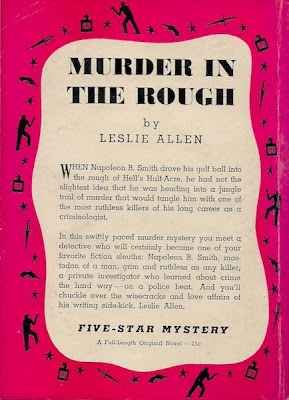Original Detective Stories
Volume 1, Number 1
April 1948
Volume 1, Number 1
April 1948
Can a magazine written entirely by one person be considered a book? Of course not, but it does come close. Original Detective Stories was published Voyageur Press, which was owned and operated by author Horace Brown. As far as I've been able to determine, he was the only staff member and only writer. The debut issue features two works of fiction – both by Brown, of course – the first being 'Murder à la Carte.' A "BOOK LENGTH NOVEL – NEVER BEFORE PUBLISHED," I first wrote about 'Murder à la Carte' fourteen years ago, wondering whether it may have found a second life as the 1950 News Stand Library novel The Penthouse Killings.
After finally managing to find a copy of the magazine, I can now report that 'Murder à la Carte' and The Penthouse Killings are in fact one and the same.
It wasn't so wild a guess; the covers suggested as much.
Original Detective Stories features four more illustrations, masthead included.
The contents page is interesting in that it ignores 'On the Blotter,' the very first piece in this very first issue. A four-paragraph, half-page editorial credited to "The Sergeant," whom I have every reason to believe is Brown himself, it begins:
The bane of a policeman's unhappy lot is the one world "Unsolved."The aftermath of War, the spiritual and moral letdown that follows brutal conflict has unleashed murder throughout Canada. Many of these cases are sex crimes of the most atrocious sort.
In fact, the homicide rate decreased in the years immediately following the Second World War.
'On the Blotter' calls for more police funding and "a tightening of the Law in the matter of of detaining known perverts until cure."
Lest you think you have Brown pegged, as a Toronto alderman he became a staunch defender of hippies and a promoter of tenants rights. We have Brown to thank for helping raise money for the Henry Moore sculpture in Nathan Philips Square after the city council had voted it down.
Horace Brown also founded of the Canadian March of Dimes (now March of Dimes Canada). He himself was stricken with polio at the age of eight months and walked with the aid of crutches. The disease influences 'The Scarf' the second of the magazine's two stories, written under the nom de plume "Leslie Allen."**
The issue has no ads. Its back cover is taken up with a challenge and appeal:
Canadian readers and advertisers did not respond. Were the magazines themselves to blame or the distributors and retailers? Frankly, I think the fault lies with Brown himself. The venture was unstable from the start. Original Detective Stories' second issue was the last. It appeared in July 1948, three months after the first.
Brown's magazine empire had one other title in its fold. Like Original Detective Stories, All Star Western Stories debuted in April 1948, published a second issue in July 1948, and then disappeared.
Brown believed that Canadians would rally to the support of Canadian publications and publishing.
He wasn't wrong.
We saw this through much of the second half of the last century and into the early years of this one. I worked for a library wholesaler and major chain for the last fifteen of those years and remember well the number of Canadian titles on the weekly Globe & Mail bestseller lists.
The newspaper's most recent hardcover fiction list features not one Canadian title. The non-fiction hardcover list has just one, Omar El Akkad's One Day, Everyone Will Have Always Been Against This. Not one title is published by a Canadian publisher.
A question for Canadians: We're boycotting American produce, booze, and travel, so why are we not boycotting American cultural product?
The newspaper's most recent hardcover fiction list features not one Canadian title. The non-fiction hardcover list has just one, Omar El Akkad's One Day, Everyone Will Have Always Been Against This. Not one title is published by a Canadian publisher.
A question for Canadians: We're boycotting American produce, booze, and travel, so why are we not boycotting American cultural product?
* Sadly, Jackson's father, a piano salesman, was not working. All evidence suggests that the boy was the family's sole breadwinner. According to the Bank of Canada Inflation Calculator, $520 in 1931 is roughly the equivalent of $10,425 today, which may explain why the Heise family was sharing the small duplex with young marrieds Timothy and Elma Breuls and the bride's mother.
** Brown had previously used "Leslie Allen" for his 1946 golfing mystery Murder in the Rough.
Related posts:





















